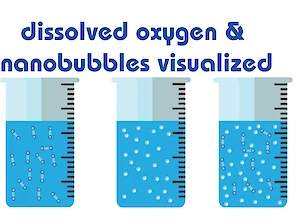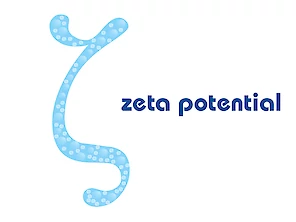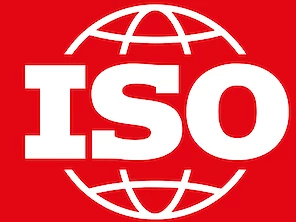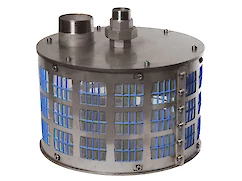dissolved oxygen and nanobubbles
Introduction
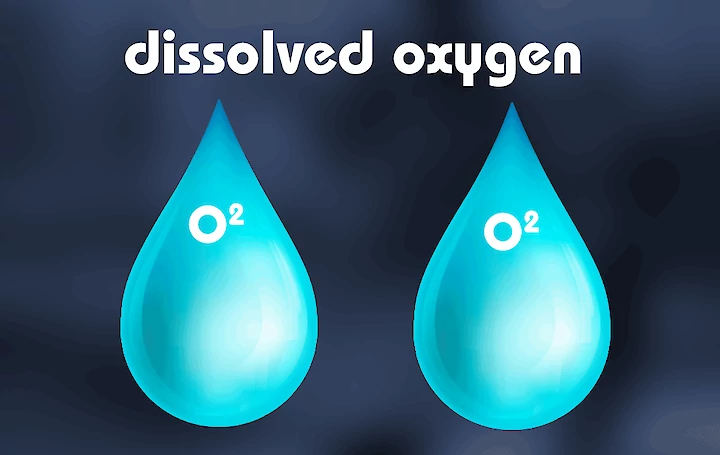
Dissolved oxygen, or DO, refers to the level of free, non-compound oxygen present in Water or other liquids. The DO value is an essential parameter for your water quality and the process where you use the Water. An ultrafine bubble, also known as a nanobubble, is not dissolved oxygen; a bubble is a gas cavity in Water or another liquid.
Conventionally, aeration is a technology to increase the DO value in Water. Now, with nanobubble technology, we have two levels to increase the oxygen in Water: the first level is the dissolved oxygen, and the second level is via bubbles or gas cavities in Water. For this reason, we also refer to nanobubble generation as an enhanced aeration technology.
The following factors influence the dissolved oxygen level:
- Temperature of the Water
- The salinity of the Water
- The altitude of operation (atmospheric pressure)
- Biology in the Water is affected by the respiration of fish and plants
The relationship between water temperature and DO is inverse: Cold Water can hold more DO than warm Water. The ultrafine bubble generators on this website pressurize gases and liquids; therefore, they can oversaturate the Water. In nature, under normal conditions, a saturation level of 100% is the maximum.
Air contains 20.95% oxygen. At standard barometric pressure (760 mmHg), the pressure or 'tension' of oxygen in air is 159 mmHg (760 x 0.2095). The pressure of oxygen in air drives oxygen into Water until the pressure of oxygen in Water is equal to the pressure of oxygen in the atmosphere. When the pressure of oxygen in Water and the atmosphere is equal, the net movement of oxygen molecules from the atmosphere to the Water stops. The Water is then in equilibrium or at saturation, with dissolved oxygen (DO), when the oxygen pressure in the Water equals the pressure of oxygen in the atmosphere.
PPM versus mg / L
We often get the question of what the difference is between DO ppm and DO mg/L. At first glance, it appears to be two very different forms of measurement. They are both ratios, and to see how they align with each other, it's easiest to start with ppm, or parts per million. As an example, let's say you're trying to determine the salinity of seawater, and you get a reading of 36,000 ppm; that means that for every million parts of Water, there are 36,000 parts of salt.
What are the parts? Parts can be measured in any unit: liters, buckets, or a drop of Water (such as orange juice or gasoline). The sample size is irrelevant. It's the RATIO of the tested parts (salt) to the total number of parts (seawater) that's important. It's easy to grasp ppm, but how about mg/L?
A liter of Water (which is a metric measure of volume, or capacity) weighs 1 kilogram. That's 1,000 grams. Now think about a milligram. It is 1/1000th of a gram, making it 1/1,000,000 th of a kilogram. Put another way, a liter of Water weighs 1,000,000 milligrams. One million milligrams… see where this is going? For our purposes, 36,000 milligrams per liter is equivalent to 36,000 parts per million.* Both measurements tell us how many parts (milligrams) are present in every million parts (liters).
In reality, for these measurements to be perfectly equal, they must be taken with pure Water at standard temperature and pressure. Most testing instruments include an automatic temperature compensation feature (ATC), which corrects for this difference.
DO values table
Dissolved oxygen values, saturation point, and oversaturated values
| Temperature | DO (mg/L) | DO (mg/L) | DO (mg/L) | DO (mg/L) | DO (mg/L) |
|---|---|---|---|---|---|
| (degrees C) | 100% | 200% | 300% | 400% | 500% |
| 0 | 14.6 | 29.2 | 43.8 | 58.4 | 73 |
| 1 | 14.19 | 28.38 | 42.57 | 56.76 | 70.95 |
| 2 | 13.81 | 27.62 | 41.43 | 55.24 | 69.05 |
| 3 | 13.44 | 26.88 | 40.32 | 53.76 | 67.2 |
| 4 | 13.09 | 26.18 | 39.27 | 52.36 | 65.45 |
| 5 | 12.75 | 25.5 | 38.25 | 51 | 63.75 |
| 6 | 12.43 | 24.86 | 37.29 | 49.72 | 62.15 |
| 7 | 12.12 | 24.24 | 36.36 | 48.48 | 60.6 |
| 8 | 11.83 | 23.66 | 35.49 | 47.32 | 59.15 |
| 9 | 11.55 | 23.1 | 34.65 | 46.2 | 57.75 |
| 10 | 11.27 | 22.54 | 33.81 | 45.08 | 56.35 |
| 11 | 11.01 | 22.02 | 33.03 | 44.04 | 55.05 |
| 12 | 10.76 | 21.52 | 32.28 | 43.04 | 53.8 |
| 13 | 10.52 | 21.04 | 31.56 | 42.08 | 52.6 |
| 14 | 10.29 | 20.58 | 30.87 | 41.16 | 51.45 |
| 15 | 10.07 | 20.14 | 30.21 | 40.28 | 50.35 |
| 16 | 9.85 | 19.7 | 29.55 | 39.4 | 49.25 |
| 17 | 9.65 | 19.3 | 28.95 | 38.6 | 48.25 |
| 18 | 9.45 | 18.9 | 28.35 | 37.8 | 47.25 |
| 19 | 9.26 | 18.52 | 27.78 | 37.04 | 46.3 |
| 20 | 9.07 | 18.14 | 27.21 | 36.28 | 45.35 |
| 21 | 8.9 | 17.8 | 26.7 | 35.6 | 44.5 |
| 22 | 8.72 | 17.44 | 26.16 | 34.88 | 43.6 |
| 23 | 8.56 | 17.12 | 25.68 | 34.24 | 42.8 |
| 24 | 8.4 | 16.8 | 25.2 | 33.6 | 42 |
| 25 | 8.24 | 16.48 | 24.72 | 32.96 | 41.2 |
| 26 | 8.09 | 16.18 | 24.27 | 32.36 | 40.45 |
| 27 | 7.95 | 15.9 | 23.85 | 31.8 | 39.75 |
| 28 | 7.81 | 15.62 | 23.43 | 31.24 | 39.05 |
| 29 | 7.67 | 15.34 | 23.01 | 30.68 | 38.35 |
| 30 | 7.54 | 15.08 | 22.62 | 30.16 | 37.7 |
| 31 | 7.41 | 14.82 | 22.23 | 29.64 | 37.05 |
| 32 | 7.28 | 14.56 | 21.84 | 29.12 | 36.4 |
| 33 | 7.16 | 14.32 | 21.48 | 28.64 | 35.8 |
| 34 | 7.05 | 14.1 | 21.15 | 28.2 | 35.25 |
| 35 | 6.93 | 13.86 | 20.79 | 27.72 | 34.65 |
| 36 | 6.82 | 13.64 | 20.46 | 27.28 | 34.1 |
| 37 | 6.71 | 13.42 | 20.13 | 26.84 | 33.55 |
| 38 | 6.61 | 13.22 | 19.83 | 26.44 | 33.05 |
| 39 | 6.51 | 13.02 | 19.53 | 26.04 | 32.55 |
| 40 | 6.41 | 12.82 | 19.23 | 25.64 | 32.05 |
| 41 | 6.31 | 12.62 | 18.93 | 25.24 | 31.55 |
| 42 | 6.22 | 12.44 | 18.66 | 24.88 | 31.1 |
| 43 | 6.13 | 12.26 | 18.39 | 24.52 | 30.65 |
| 44 | 6.04 | 12.08 | 18.12 | 24.16 | 30.2 |
| 45 | 5.95 | 11.9 | 17.85 | 23.8 | 29.75 |
Solubility of oxygen in Water
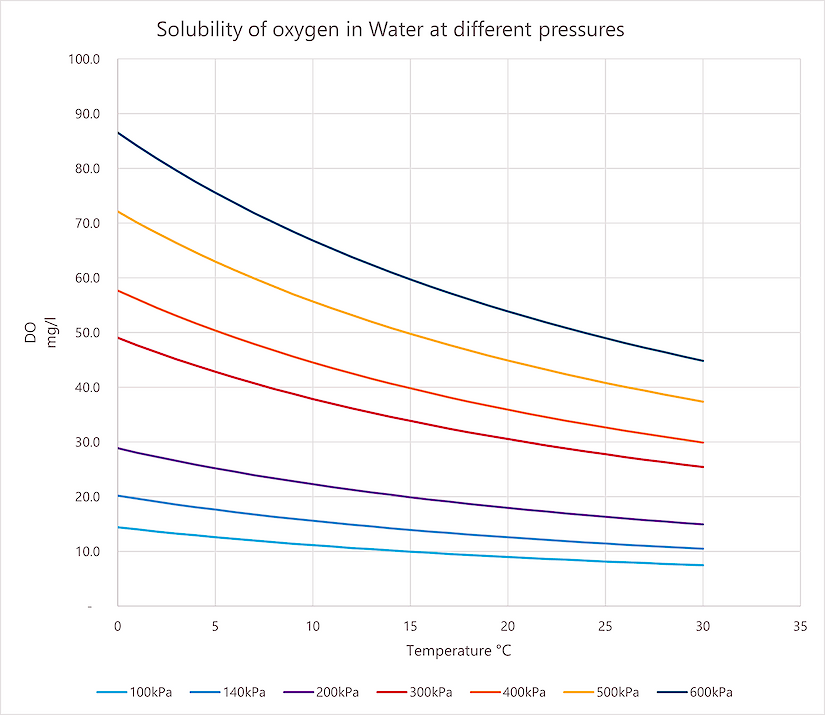
Graph the solubility of oxygen in Water at different pressures. When selecting an oxygen concentrator, ensure it matches your desired pressure setting.
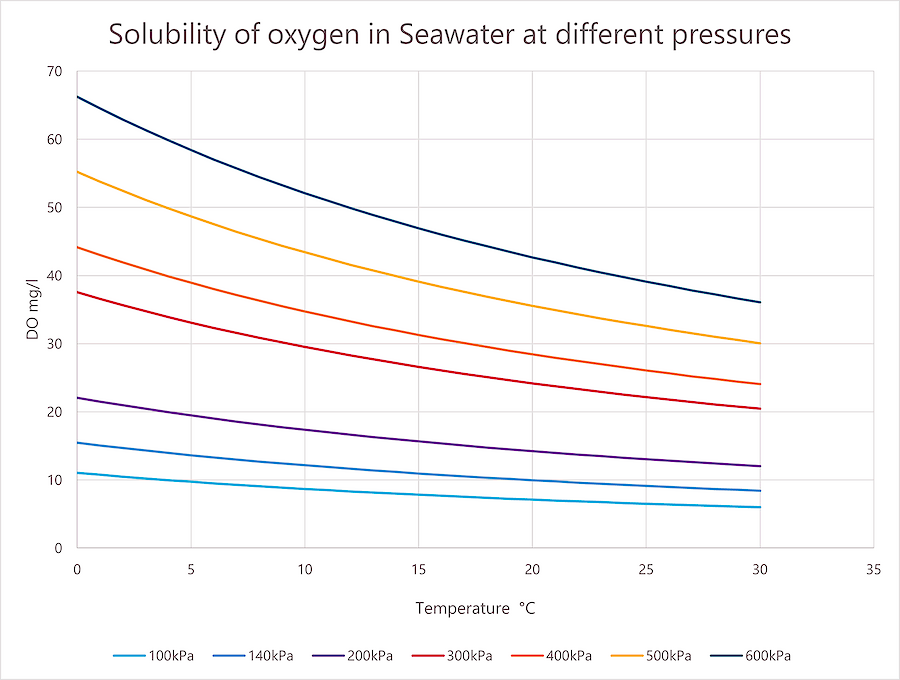
Graph the solubility of oxygen in seawater at different pressures. When a graph with different salinity is required, contact us for a calculation.
Approximate Breakdown of gases dissolved in water and in air
| Gas | Percentage in Air | Approx. % of Total Dissolved Gases in Water | Concentration (mg/L) |
|---|---|---|---|
| Nitrogen (N₂) | 78.1% | ~62–65% | ~13–14 mg/L |
| Oxygen (O₂) | 20.9% | ~30–34% | ~8–9 mg/L |
| Argon (Ar) | 0.93% | ~1.3% | ~0.4 mg/L |
| Carbon dioxide (CO₂) | ~0.04% | ~1.5–6% (varies widely) | ~0.5 mg/L (can be much higher in some water) |
Links
28 Links to other pages: dissolved oxygen
Dissolved Oxygen Control System: DO controller for applications that require a high accuracy of dissolved oxygen levels such as aquaculture and water treatment aeration. In combination with the DO controller achieve an optimal environment with energy savings by running the equipment for the minimum time required by the settings.
Hand-held oxygen and temperature meter with NFC tags and Bluetooth technology
Oxygen plays an important role in plant respiration, which causes energy production and plant growth. Increasing the percentage of oxygen in water improves the root structure and the activity of useful microbes in the rhizosphere. Naturally, an effective and practical system can increase productivity by improving the quality of irrigation water and increasing dissolved oxygen in irrigation water. Acniti oxygen concentrator and Acniti turbiti O3 are very effective supplements for irrigation of agricultural fields and at the same time improve water quality and increase dissolved oxygen (DO) and ozone in irrigation water. To determine the role of oxygen and ozone nanobubbles in the growth of lettuce, an experimental research was conducted. Research showed that by using Acniti nanobubbles generators, will increase the level of dissolved oxygen in water, and makes the roots of lettuce grow more and its weight increases significantly.
Large volume submersible ultrafine bubble generator in combination with a dissolved oxygen generator, for aerating effectively lakes, horticulture, fishponds and shrimp cultivation. Aeration is for many biological processes very important the Acniti submersible unit guarantees high DO values for ideal biological activities creating an optimal environment for high production output.
The turbiti nanobubble generator is a first-class workhorse. Turbiti can be placed in the most demanding environments. The nanobubble generator requires a low head pump, so it's efficient in energy usage. Combined with the benefits of a static mixer, Acniti has implemented their proprietary swirl flow technology to generate efficiently and effectively nanobubbles. The turbiti OEM series gives dealers and partners the opportunity to implement the turbiti into their own equipment. The Turbiti concept gives you a worry free nanobubble solution.
Low cost Ultrafine Bubble Monitoring ALT-9F17 system, to measure reliably the concentration of ultrafine bubbles (nanobubbles) in your water.
Effect of air nanobubbles on oxygen transfer, oxygen uptake, and diversity of aerobic microbial consortium in activated sludge reactors
Bubbles are all around us, in our foods, beer, pop drinks bread and cheese, but also in the bricks of our house. Bubbles are gas-filled cavities in water, the lifetime of a bubble is short at most a few minutes, only ultra-fine bubbles are stable for longer periods like months, that is making them very special and that enables us to change the properties of water.
Dissolved components measurement systems are instruments employed to determine the minor components concentration present in water when it's dissolved. The developed CX-100-II revolutionizes water quality analysis by utilizing the Vapor–liquid separator method for accurate measurement dissolved gases including ozone in water. Unlike conventional methods, it swiftly eliminates dissolved ozone and interferences, providing reliable on-site measurements. Its versatility in detecting minute sample quantities and ability to measure heavily polluted water beyond set concentrations make it a valuable tool. This innovation is particularly beneficial for applications like disinfecting water and maintaining water quality standards. With its user-friendly operation and robust performance, the CX-100-II stands as a significant advancement in water component analysis for various fields.
Nanobubbles are gas filled cavities in water. The contact area between bubbles in water filled with tiny bubbles is much larger than water filled with bigger bubbles. The gas pressure inside a small bubble is higher than in a large bubble, therefore the surface tension of a small bubble is higher as well.
Washing of surfaces and laundry is one of the promising areas were nanobubbles can make a difference in the application. Reducing the amount of detergent, has a positive effect by reducing pollution, washing laundry without detergent, would greatly benefit the environment. Nanobubbles can lower the surface tension of water, the large amounts of oxygen molecules in bubbles charge the water negative.
The miniGaLF is ACNITI`s entry level GaLF model designed for companies, universities, research institutes and individuals that want to learn about Ultrafine bubble technology. In this blog a movie is shown of the connections and the performance to create ultrafine bubble (nanobubbles) with high DO water.
Algae blooms are often a reason to start pond remediation. Probiotics in combination with ultra-fine bubbles can increase the efficiency of the wastewater treatment process. Acniti supplies probiotics in tablet form an easy and safe way to dose and apply the beneficial bacteria.
Water is one of the fundamental components of life. A large part of living cells is made up of water. Birds need twice as much water as the food they eat. To satisfy the need for water in poultry and birds, you must make water freely available to them. Note that the unavailability and limitation of water consumed by poultry slows down their growth. The water used in poultry feeding should not contain parasites, bacteria, pollution or chemicals, and fresh and clean drinking water must be provided. Bacterial agents are one of the most common water-borne infections. Drinking contaminated and untreated water can cause huge losses in the poultry industry. Using chemicals and antibiotics to disinfect drinking water can cause health problems and drug resistance in chickens. In the last decade, researchers have tried to find a suitable alternative to disinfect and improve the quality of drinking water for farm animals, especially chickens. One of the most available and best options is oxygen-nanobubbles water. By providing oxygen- nanobubbles water, the growth and development of chickens increases, and on the other hand, it enhances their resistance against microbial infections. In this article, we evaluate the benefits of oxygen-nanobubbles water in the poultry industry.
Concrete is the main part of building materials and it is almost impossible to replace concrete with other natural resources. According to several scientific articles, the application of nanobubbles improved the compressive and tensile strength of concrete. on the other hand, mixture of zeolite, Chekneh pozzolan, and nanobubbles water significantly improve the strength and durability of the concrete, which is a meaningful alternative to cement and mixing water to reduce air pollution, increase concrete performance, and reduce concrete production costs. Nanobubbles technology is the best, cheapest, simplest and safest way to improve the mechanical feature of constructional materials.
Carnation flower growers in Japan use nanobubble irrigation technology against fusarium, withering and dying plants, to improve stem quality, flower size, shoot count, volume of stems and growth speed. In the growing season 2017 / 2018, acniti conducted trials, the test area had irrigation water with billions of ultrafine bubbles of an average size of 110 nm and high DO water with 30 mg/l.
Selecting a nanobubble generator can be a daunting task when you are new to the technology. In the following article we explain the differences of the various units. This helps you to select the best nanobubble generator for your research, application development or ultrafine bubble production.
Acniti partner Foreport in Taiwan conducted a vegetables young plant cultivation trial, irrigating with oxygen nanobubbles. The nanobubble irrigation water had a DO of 20 ppm versus the regular irrigation water which had 6.8 ppm. After 6 weeks results were taken it was concluded that the crop treated with nanobubbles was 25-30% heavier. The nanobubble irrigated crop also had a better developed root system which will lead to less root diseases and better survival rates during hot summers.
The electrical properties of gas bubbles are important in determining the interaction of nano-bubbles if and when they merge together and how they interact with other materials such as solid particles or oil droplets. Knowledge about this helps application development in for example, protein skimmers, froth flotation, food processing, washing surfaces and purification.
Nanobubbles are useful in accelerating the metabolism of living organisms, but the mechanism is not yet well understood. In a study, they investigated the production of reactive oxygen species (ROS) by Nano Bubbles and the effect on seed germination. The conclusion of the study was seeds in nanobubble water had a higher germination rate than all those submerged in the different other conventional used solutions.
Ozone nanobubbles are attractive for water purification, treatment, and disinfection. ozone nanobubbles have a higher mass transfer rate than ordinary bubbles and there for nanobubbles more efficiently use ozone as a powerful oxidizing agent and sterilizer to kill or inactivate bacteria and viruses.
Acniti manufacturer and marketing and sales organization for nanobubble technology and industrial oxygen concentrators.
oxiti Ozone is an industrial oxygen concentrator with a built-in ozone concentrator.
The oxiti booster is an industrial oxygen concentrator that meets the demand for higher pressure oxygen gas for the generation of nanobubbles.
The wall mounted Turbiti is the multipurpose nanobubble generator suitable for agriculture, horticulture and fish cultivation sites. Super saturation of oxygen for water day storage tanks in horticulture. Drinking water solutions for chicken, cows, pigs and horses, giving high DO water with ultrafine bubbles to animals with enhance their food digestion more efficiently and results in healthier animals.
The Turbiti O2 pump skid is the multipurpose ultrafine bubble generator suitable for agriculture, horticulture and fish cultivation sites. Super saturation of oxygen for water day storage tanks in horticulture. Drinking water solutions for chicken, cows, pigs and horses, giving high DO water with ultrafine bubbles to animals with enhance their food digestion more efficiently and results in healthier animals.
Acniti sells oxygen concentrators, ozone generators with oxygen concentrators and ozone gas sensors
